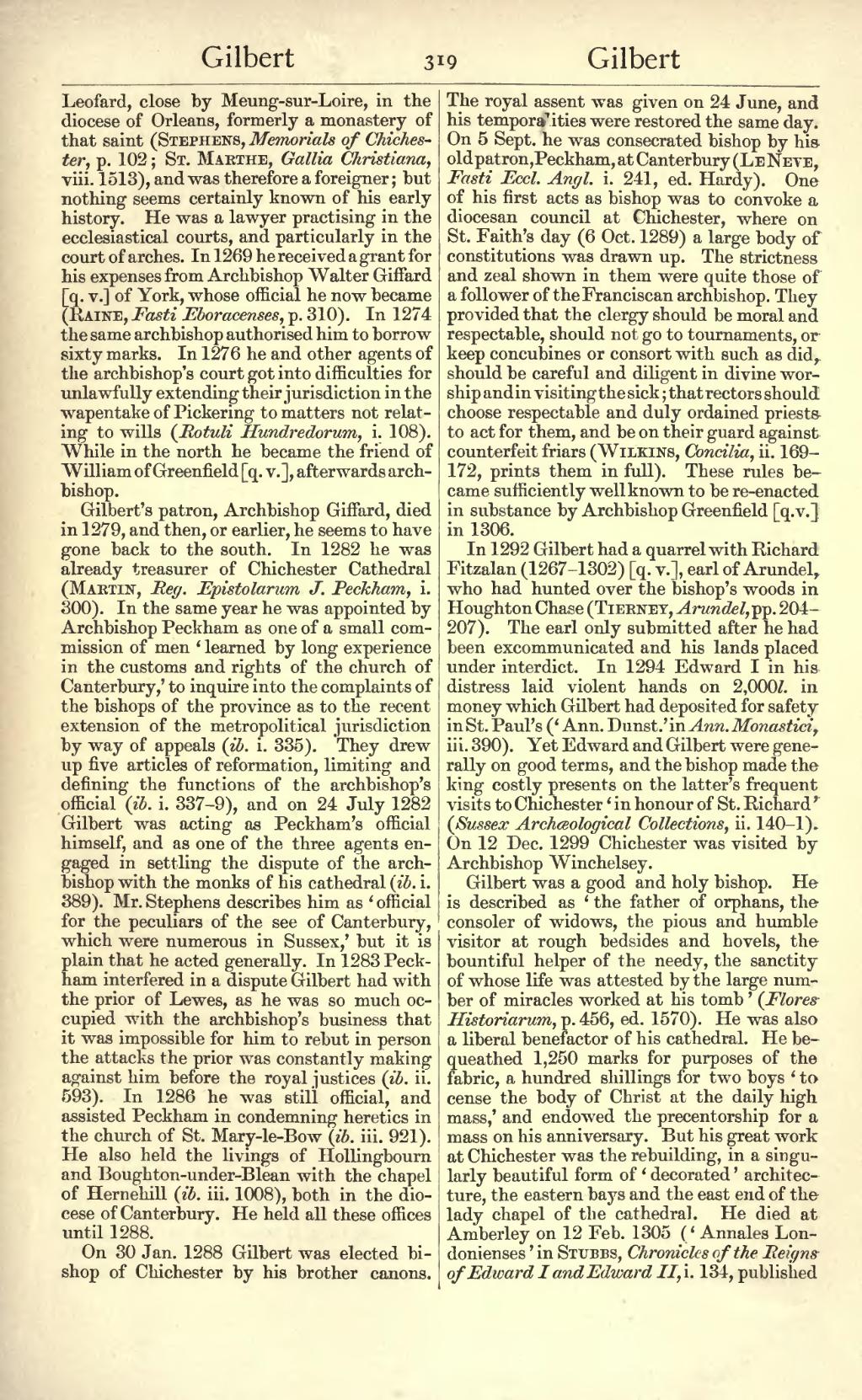Leofard, close by Meung-sur-Loire, in the diocese of Orleans, formerly a monastery of that saint (Stephens, Memorials of Chichester, p. 102; St. Marthe, Gallia Christiana, viii. 1513), and was therefore a foreigner; but nothing seems certainly known of his early history. He was a lawyer practising in the ecclesiastical courts, and particularly in the court of arches. In 1269 he received a grant for his expenses from Archbishop Walter Giffard [q. v.] of York, whose official he now became (Raine, Fasti Eboracenses, p. 310). In 1274 the same archbishop authorised him to borrow sixty marks. In 1276 he and other agents of the archbishop's court got into difficulties for unlawfully extending their jurisdiction in the wapentake of Pickering to matters not relating to wills (Rotuli Hundredorum, i. 108). While in the north he became the friend of William of Greenfield [q. v.], afterwards archbishop.
Gilbert's patron, Archbishop Giffard, died in 1279, and then, or earlier, he seems to have gone back to the south. In 1282 he was already treasurer of Chichester Cathedral (Martin, Reg. Epistolarum J. Peckham, i. 300). In the same year he was appointed by Archbishop Peckham as one of a small commission of men ‘learned by long experience in the customs and rights of the church of Canterbury,’ to inquire into the complaints of the bishops of the province as to the recent extension of the metropolitical jurisdiction by way of appeals (ib. i. 335). They drew up five articles of reformation, limiting and defining the functions of the archbishop's official (ib. i. 337–9), and on 24 July 1282 Gilbert was acting as Peckham's official himself, and as one of the three agents engaged in settling the dispute of the archbishop with the monks of his cathedral (ib. i. 389). Mr. Stephens describes him as ‘official for the peculiars of the see of Canterbury, which were numerous in Sussex,’ but it is plain that he acted generally. In 1283 Peckham interfered in a dispute Gilbert had with the prior of Lewes, as he was so much occupied with the archbishop's business that it was impossible for him to rebut in person the attacks the prior was constantly making against him before the royal justices (ib. ii. 593). In 1286 he was still official, and assisted Peckham in condemning heretics in the church of St. Mary-le-Bow (ib. iii. 921). He also held the livings of Hollingbourn and Boughton-under-Blean with the chapel of Hernehill (ib. iii. 1008), both in the diocese of Canterbury. He held all these offices until 1288.
On 30 Jan. 1288 Gilbert was elected bishop of Chichester by his brother canons. The royal assent was given on 24 June, and his temporalities were restored the same day. On 5 Sept. he was consecrated bishop by his old patron, Peckham, at Canterbury (Le Neve, Fasti Eccl. Angl. i. 241, ed. Hardy). One of his first acts as bishop was to convoke a diocesan council at Chichester, where on St. Faith's day (6 Oct. 1289) a large body of constitutions was drawn up. The strictness and zeal shown in them were quite those of a follower of the Franciscan archbishop. They provided that the clergy should be moral and respectable, should not go to tournaments, or keep concubines or consort with such as did, should be careful and diligent in divine worship and in visiting the sick; that rectors should choose respectable and duly ordained priests to act for them, and be on their guard against counterfeit friars (Wilkins, Concilia, ii. 169–172, prints them in full). These rules became sufficiently well known to be re-enacted in substance by Archbishop Greenfield [q. v.] in 1306.
In 1292 Gilbert had a quarrel with Richard Fitzalan (1267–1302) [q. v.], earl of Arundel, who had hunted over the bishop's woods in Houghton Chase (Tierney, Arundel, pp. 204–207). The earl only submitted after he had been excommunicated and his lands placed under interdict. In 1294 Edward I in his distress laid violent hands on 2,000l. in money which Gilbert had deposited for safety in St. Paul's (‘Ann. Dunst.’ in Ann. Monastici, iii. 390). Yet Edward and Gilbert were generally on good terms, and the bishop made the king costly presents on the latter's frequent visits to Chichester ‘in honour of St. Richard’ (Sussex Archæological Collections, ii. 140–1). On 12 Dec. 1299 Chichester was visited by Archbishop Winchelsey.
Gilbert was a good and holy bishop. He is described as ‘the father of orphans, the consoler of widows, the pious and humble visitor at rough bedsides and hovels, the bountiful helper of the needy, the sanctity of whose life was attested by the large number of miracles worked at his tomb’ (Flores Historiarum, p. 456, ed. 1570). He was also a liberal benefactor of his cathedral. He bequeathed 1,250 marks for purposes of the fabric, a hundred shillings for two boys ‘to cense the body of Christ at the daily high mass,’ and endowed the precentorship for a mass on his anniversary. But his great work at Chichester was the rebuilding, in a singularly beautiful form of ‘decorated’ architecture, the eastern bays and the east end of the lady chapel of the cathedral. He died at Amberley on 12 Feb. 1305 (‘Annales Londonienses’ in Stubbs, Chronicles of the Reigns of Edward I and Edward II, i. 134, published
